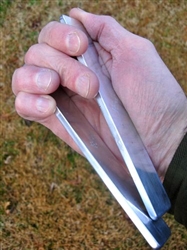 |
Aluminum
Aluminum is a low density metal that delivers a strong thick "chunky" tone. Depending on the grip, you can also generate clank, chime, or swish tones.
Aluminum is the most widely used non-ferrous metal and the most abundant metal in the Earth's crust. It is about one-third the density and stiffness of steel. The 6061 alloy is one of the most common blends for general purpose aluminum.
Bone Rattling Facts
Aluminum and other metal bones work great with any tune that calls for the sound of metal spoons. Metal bones work especially well with Cajun music.
Metal bones are one of the few kinds of musical bones that let you create an unusual sound by sliding the edges. How do you get the sound? It's easy. Rather than tapping the faces together, scissor the bones so the edges slide against each other instead.
Aluminum works well for handheld musical instruments because it is non-magnetic, resists corrosion and does not rust. But metal bones are not for everyone. They will leave their mark on you - literally. After rattling these instruments you will see a metallic smudge-like residue on your hands. The residue is non-sticky thank goodness, and washes off easily with soap and water.
Cool Facts
The 6061 aluminum alloy is the same one used for the Pioneer spacecraft greeting plaque.
Legend has it that Emperor Napoleon III of France gave a banquet where the most honored guests were given utensils made of aluminum - while other guests had to make do with gold.
Aluminum has been produced in commercial quantities for over 100 years. It is an important component of silver paint.
The Washington Monument was topped with a 6 pound (2.8 kg) aluminum capstone in 1884. At the time this was the largest single piece of cast aluminum - and as expensive as silver.
The atomic number of aluminum is 13.
Figures below are approximate (but pretty darn close)
Tonality
Can't Decide Which Bones to Choose?
Check out this handy guide: Bone FAQs
|
|
Aluminum Facts
Grain
A linear grain runs the length of extruded aluminum bars.
Texture
Depending on surface roughness, the texture of extruded aluminum is somewhat clefted and dull. Buffing and polish makes aluminum smooth and shiny.
Luster
Aluminum polishes to a bright shiny metallic silver.
Metal Color
Gray to silver
(Silver Energy Bar)
Aluminum ranges from dingy gray to bright silver. Buffing and polish brings out the shine.
Aroma
None.
Metalworking
The material is ductile and easily worked with a chop saw, bench grinder, wet grinder and buffer.
Alloy Name
6061 Aluminum
Other Names
Aluminium
Environmental Profile
Aluminum is 100% recyclable. The chief source of aluminum is bauxite ore. Large deposits of bauxite occur in Australia, Brazil, Guinea and Jamaica but the primary mining areas for the ore are in Ghana, Indonesia, Jamaica, Russia and Surinam.
Smelting of the ore mainly occurs in Australia, Brazil, Canada, Norway, Russia and the United States.
Distribution
Aluminium is the most abundant metal in the Earth's crust. It makes up about 8% by weight of the Earth's solid surface. Although aluminium is the most abundant metallic element in the Earth's crust, it is rare in its free form, occurring in oxygen-deficient environments such as volcanic mud, and it was once considered a precious metal more valuable than gold.
Health Concerns
Wikipedia reports that a small percentage of people are allergic to aluminum and experience contact dermatitis, digestive disorders, vomiting or other symptoms upon contact or ingestion of products containing aluminum, such as deodorants or antacids.
The use of aluminum cookware has not been shown to lead to aluminum toxicity. And according to The Alzheimer's Society, no causal relationship between aluminum and Alzheimer's disease has been convincingly demonstrated.
Alloy Data
6061 is a precipitation hardening aluminum alloy, containing magnesium and silicon as its major alloying elements. It is pre-tempered, solutionized and artificially aged.
Below is the alloy composition of 6061 as reported by Wikipedia:
Silicon minimum 0.4%, maximum 0.8% by weight
Iron no minimum, maximum 0.7%
Copper minimum 0.15%, maximum 0.40%
Manganese no minimum, maximum 0.15%
Magnesium minimum 0.8%, maximum 1.2%
Chromium minimum 0.04%, maximum 0.35%
Zinc no minimum, maximum 0.25%
Titanium no minimum, maximum 0.15%
Other elements no more than 0.05% each, 0.15% total
Remainder Alumin.
|
|
|